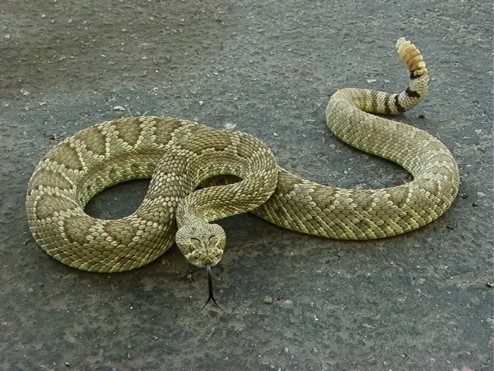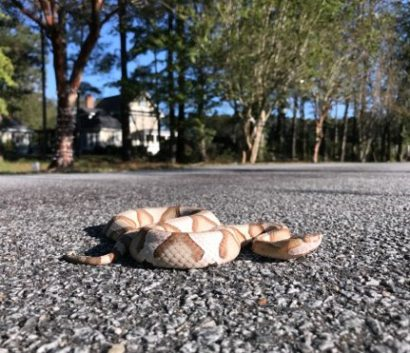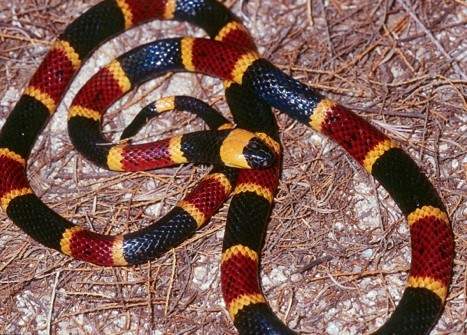Venomous snakes found in the United States include rattlesnakes, copperheads, cottonmouths/water moccasins, and coral snakes. They can be dangerous to outdoor workers including farmers, foresters, landscapers, groundskeepers, gardeners, painters, roofers, pavers, construction workers, laborers, mechanics, and any other workers who spend time outside.
A venomous bite is called an “envenomation.” Although rare, some workers with a severe envenomation or allergy to snake venom may be at risk of death if bitten. It has been estimated that 7,000–8,000 people per year receive venomous bites in the United States, and about 5 of those people die. The number of deaths would be much higher if people did not seek medical care. Disability and permanent injury (such as the loss of part or all of a finger or the function of it) are much more common, reported to be between 10 and 44 percent in patients with rattlesnake bites.
It is important for employers to train their workers about their risk of exposure to venomous snakes, how they can prevent and protect themselves from snake bites, and what they should do if they are bitten.
Types of Venomous Snakes
Rattlesnakes
There are many species of rattlesnakes in the United States. Rattlesnakes are the largest of the venomous snakes in the United States. They can quickly and accurately strike one-third or more of their body length from any position, whether coiled or stretched out. Rattlesnakes may use their rattles as a warning when they feel threatened, although they do not always rattle before biting. Rattlesnakes may be found sunning themselves near logs, boulders, or open areas. These snakes may be found in most work habitats including the mountains, prairies, deserts, and beaches. Antivenom is recommended for the treatment of signs of progressive envenomation (e.g., worsening of local tissue injury, systemic symptoms).

U.S. Geographic Region: Across the United States.
Copperheads
Copperheads vary in color from reddish to golden tan. The colored bands on their body are typically hourglass-shaped. They have a deep facial pit between each eye and their nostril. Most adults are about 18–36 inches long. They are not usually aggressive, but will often freeze when frightened and will strike in defense if threatened, contacted or interacted with. Workers are more likely to be bitten when they unknowingly step on or near a copperhead. Copperheads are often found in forests, rocky areas, swamps, or near sources of water like rivers. Early administration of antivenom results in faster limb recovery and reduced limb disability after copperhead snake envenomation.

U.S. Geographic Region: Eastern states, extending as far west as Texas.
Cottonmouths/Water Moccasins
Cottonmouth snakes average 50–55 inches long. The adult snake’s skin is dark tan, brown, or nearly black, with vague black or dark brown cross-bands. Juveniles have a bold cross-banded pattern of brown or orange with a yellow tail. Cottonmouths are frequently found in or around water.

U.S. Geographic Region: Wetland areas, rivers, lakes, etc., in the southeastern states.
Coral Snakes.
These snakes are sometimes confused with nonvenomous king snakes, which have similar colored bands although in a different arrangement. Coral snakes tend to hide in leaf piles or burrow into the ground.

U.S. Geographic Region: Wooded, sandy, or marshy areas of the Southern United States.
Recommendations
Employer Recommendations
Employers should protect their workers from venomous snake bites by training them about:
- Their risk of exposure to venomous snakes
- How to identify venomous snakes
- How to prevent snake bites
- What they should do if they are bitten by a snake
Worker Recommendations
Workers should take the following steps to prevent a snake bite:
- Do not try to handle any snake.
- Stay away from tall grass and piles of leaves when possible.
- Avoid climbing on rocks or piles of wood where a snake may be hiding.
- Be aware that snakes tend to be active at night and in warm weather.
- Wear boots and long pants when working outdoors.
- Wear leather gloves when handling brush and debris.
Symptoms and First Aid
Symptoms
Signs or symptoms associated with a snake bite may vary depending on the type of snake, but may include:
- A pair of puncture marks at the wound
- Redness and swelling around the bite
- Severe pain at the site of the bite
- Nausea and vomiting
- Labored breathing (in extreme cases, breathing may stop altogether)
- Disturbed vision
- Increased salivation and sweating
- Numbness or tingling around your face and/or limbs
First Aid
Workers should take the following steps if they are bitten by a snake:
- Seek medical attention as soon as possible (dial 911 or call local Emergency Medical Services.)
- Try to remember the color and shape of the snake, which can help with treatment of the snake bite.
- Keep still and calm. This can slow down the spread of venom.
- Inform your supervisor.
- Apply first aid if you cannot get to the hospital right away.
- Lay or sit down with the bite below the level of the heart.
- Wash the bite with soap and water.
- Cover the bite with a clean, dry dressing.
Do NOT do any of the following:
- Do not pick up the snake or try to trap it.
- Do not wait for symptoms to appear if bitten, seek immediate medical attention.
- Do not apply a tourniquet.
- Do not slash the wound with a knife.
- Do not suck out the venom.
- Do not apply ice or immerse the wound in water.
- Do not drink alcohol as a painkiller.
- Do not drink caffeinated beverages.
This article and photos are courtesy of The National Institute of Occupational Safety and Health (NIOSH) and the Centers for Disease Control and Prevention (CDC). You may view other health-related topics by visiting www.cdc.gov/niosh/topics.
